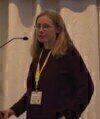Identification and validation of methane sources using carbon-13 measurements
For more specific analyses of atmospheric methane, follow the link to a survey of atmospheric methane at a regional level, or click through to an e-Learning on urban monitoring, using two European cities as case-studies.
Carbon 13/12 ratios of methane are controlled by the processes and temperature of formation of methane, such that methane produced by cool biogenic processes contains less 13C than methane produced by higher temperature thermogenic (fossil fuels) and pyrogenic (combustion sources). This ratio can be used to characterise individual source categories, such as those designated within emission inventories (such as NAEI in the UK, or EDGAR globally) like landfill or natural gas distribution, but at a finer scale can distinguish individual production pathways as in sewage treatment plants.
Individual processes can change the isotopic ratios at very small scales, particularly where biological pathways are involved, so that very small-scale ground based surveys, such as with chambers, can give large isotopic heterogeneities across a single source site. The ability of mass spectrometers and now laser-spectrometers to measure the isotopic signatures of methane in air at ambient background concentrations (<2ppm) means that emission plumes from whole installations and ground sites can be integrated and isotopically characterised. Some of these sources have consistent isotopic ratios over national to global areas (landfill sites give the same signature in many countries), whereas others can be characterised at a regional scale. This is particularly true for natural gas emissions, such that West Siberian production and distribution is different from the southern North Sea, which is different from the northern North Sea. Signatures of emissions from coal are primarily related to coal rank and temperature of formation (e.g. Zazzeri et al., 2016).
Since 2013 we have used laser spectroscopy (CRDS) to identify methane plumes for collection of samples for isotopic analysis (Zazzeri et al., 2015). Multi-repeat regional surveys allow seasonal isotopic differences to be identified (different practices, or proportions of fossil to biogenic methane use and emission) and the mapping of ephemeral sources such as gas leaks. Background isotopic surveys in regions of potential fracking increase the likelihood of identification of future production leaks.
Detailed source characterisation coupled with wind field analysis is now allowing interpretation of the causes of isotopic shifts and anomalies in global background records over decadal time-scales (e.g. Nisbet et al., 2016).
Free to watch
Sessions are free to watch. Please login to view this session or create an account.
Speakers

Dr Rebecca Fisher (Royal Holloway, University of London)
Digital Edition
PIN 25.3 June/July
June 2024
Analytical Instrumentation - Recent Advances In Various Bench Scale Accelerated Oxidative Testing Methods For Fuels - Petrochemical Industry: Anton Paar Solutions Streamline Processes, Reduce H...
View all digital editions
Events
Jul 30 2024 Jakarta, Indonesia
Jul 30 2024 Jakarta, Indonesia
China Energy Summit & Exhibition
Jul 31 2024 Beijing, China
Jul 31 2024 Chengdu, China
Aug 05 2024 Moon Township, PA, USA














